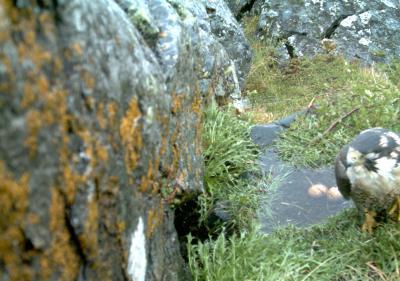Rain, crucial to sustaining life on Earth, is proving deadly for young peregrine falcons in Canada's Arctic.
A University of Alberta study recently published in Oecologia has found that an increase in the frequency of heavy rain brought on by warmer summer temperatures is posing a threat not seen in this species since before pesticides such as DDT were banned from use in Canada in 1970.
The study is among the first to directly link rainfall to survival of wild birds in Canada.
A nestbox experiment at the heart of a study co-authored by U of A researcher Alastair Franke and colleagues at the Université du Québec has provided "unequivocal evidence" that gradual changes in Arctic temperature and precipitation are responsible for a long-term decline in reproduction for the peregrine, a top predator in the Arctic.
Armed with historical weather data and measures of breeding success dating back to 1980, the researchers conducted a nestbox experiment from 2008 to 2010 in a dense population of peregrines breeding near Rankin Inlet in Nunavut on the shores of the Hudson Bay. Falcon nests were monitored using motion-sensitive cameras, and images confirmed that more than one-third of the chick deaths recorded were caused by rain, whether they were raised in nestboxes or on natural ledges.

A peregrine sits outside her flooded nest, unable to hatch her eggs.
(Photo Credit: Photo used with permission of University of Alberta.)
"The nestlings died from hypothermia and in some cases from drowning in their flooded nests. Without constant parental care, they are most vulnerable to cold and wet conditions in the first three weeks of life," Franke said.
Over the past 30 years, scientists have been surprised to discover an ongoing decline, even when pesticide residues were known to be too low to cause reproductive failure in the peregrines. "We knew DDT was no longer an issue and based on field observations, we wondered whether changes in climate were responsible for high mortality in recent years," Franke said.
Besides deaths attributed to rainfall, the study also discovered additional fallout for chicks: starvation "We were surprised to find that a considerable number of nestlings raised in nestboxes later died of starvation despite having been spared from the direct effects of rain."
Grim as the study's findings are, "they have improved our understanding of the direct effects of long-term changes in weather patterns and have identified the potential importance of indirect effects," Franke said. The work also shows that wildlife can be sensitive to many different environmental pressures and that ongoing vigilance and monitoring is critical, he noted.
Source: University of Alberta